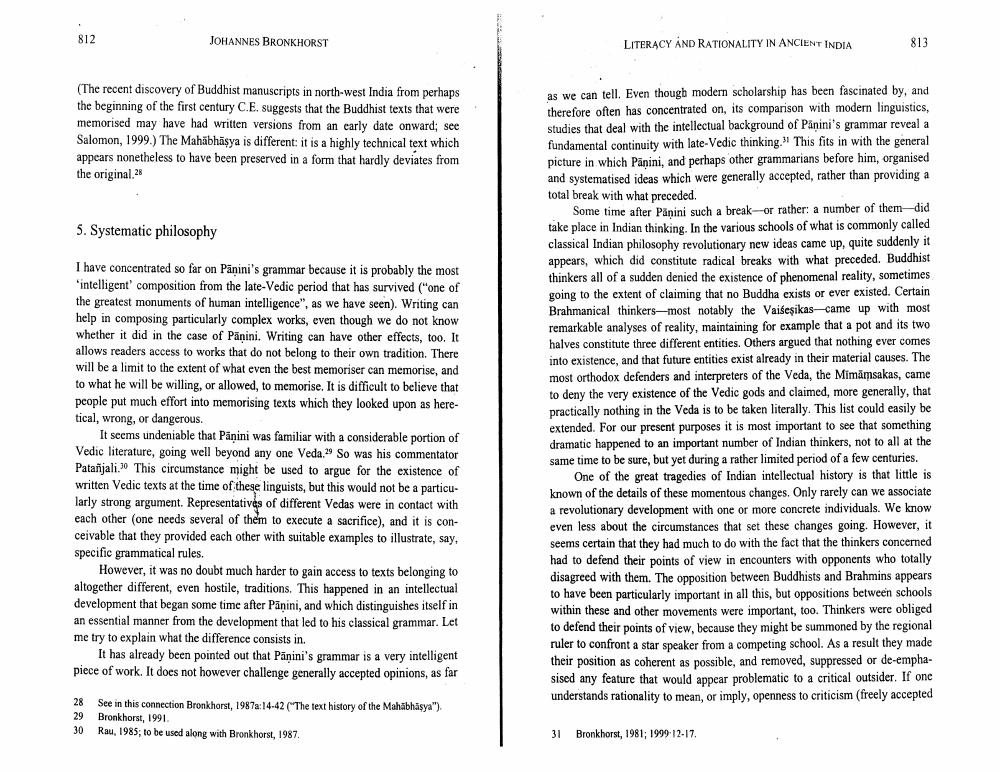Book Title: Literacy And Rationality In Ancient India Author(s): Johannes Bronkhorst Publisher: Johannes Bronkhorst View full book textPage 9
________________ JOHANNES BRONKHORST LITERACY AND RATIONALITY IN ANCIENT INDIA 813 (The recent discovery of Buddhist manuscripts in north-west India from perhaps the beginning of the first century C.E. suggests that the Buddhist texts that were memorised may have had written versions from an early date onward; see Salomon, 1999.) The Mahabhäsya is different: it is a highly technical text which appears nonetheless to have been preserved in a form that hardly deviates from the original.28 5. Systematic philosophy I have concentrated so far on Panini's grammar because it is probably the most 'intelligent composition from the late-Vedic period that has survived ("one of the greatest monuments of human intelligence", as we have seen). Writing can help in composing particularly complex works, even though we do not know whether it did in the case of Pānini. Writing can have other effects, too. It allows readers access to works that do not belong to their own tradition. There will be a limit to the extent of what even the best memoriser can memorise, and to what he will be willing, or allowed, to memorise. It is difficult to believe that people put much effort into memorising texts which they looked upon as heretical, wrong, or dangerous. It seems undeniable that Panini was familiar with a considerable portion of Vedic literature, going well beyond any one Veda.” So was his commentator Patañjali. This circumstance might be used to argue for the existence of written Vedic texts at the time of these linguists, but this would not be a particularly strong argument. Representatives of different Vedas were in contact with each other one needs several of them to execute a sacrifice), and it is conceivable that they provided each other with suitable examples to illustrate, say, specific grammatical rules. However, it was no doubt much harder to gain access to texts belonging to altogether different, even hostile, traditions. This happened in an intellectual development that began some time after Panini, and which distinguishes itself in an essential manner from the development that led to his classical grammar. Let me try to explain what the difference consists in. It has already been pointed out that Panini's grammar is a very intelligent piece of work. It does not however challenge generally accepted opinions, as far as we can tell. Even though modern scholarship has been fascinated by, and therefore often has concentrated on, its comparison with modern linguistics, studies that deal with the intellectual background of Panini's grammar reveal a fundamental continuity with late-Vedic thinking. This fits in with the general picture in which Panini, and perhaps other grammarians before him, organised and systematised ideas which were generally accepted, rather than providing a total break with what preceded. Some time after Panini such a break-or rather: a number of them did take place in Indian thinking. In the various schools of what is commonly called classical Indian philosophy revolutionary new ideas came up, quite suddenly it appears, which did constitute radical breaks with what preceded. Buddhist thinkers all of a sudden denied the existence of phenomenal reality, sometimes going to the extent of claiming that no Buddha exists or ever existed. Certain Brahmanical thinkers-most notably the Vaišeşikas came up with most remarkable analyses of reality, maintaining for example that a pot and its two halves constitute three different entities. Others argued that nothing ever comes into existence, and that future entities exist already in their material causes. The most orthodox defenders and interpreters of the Veda, the Mimamsakas, came to deny the very existence of the Vedic gods and claimed, more generally, that practically nothing in the Veda is to be taken literally. This list could easily be extended. For our present purposes it is most important to see that something dramatic happened to an important number of Indian thinkers, not to all at the same time to be sure, but yet during a rather limited period of a few centuries. One of the great tragedies of Indian intellectual history is that little is known of the details of these momentous changes. Only rarely can we associate hary development with one or more concrete individuals. We know even less about the circumstances that set these changes going. However, it seems certain that they had much to do with the fact that the thinkers concerned had to defend their points of view in encounters with opponents who totally disagreed with them. The opposition between Buddhists and Brahmins appears to have been particularly important in all this, but oppositions between schools within these and other movements were important, too. Thinkers were obliged to defend their points of view, because they might be summoned by the regional ruler to confront a star speaker from a competing school. As a result they made their position as coherent as possible, and removed, suppressed or de-emphasised any feature that would appear problematic to a critical outsider. If one understands rationality to mean, or imply, openness to criticism (freely accepted 28 29 30 See in this connection Bronkhorst, 1987:14-42 ("The text history of the Mahabhiya") Bronkhorst, 1991 Rau, 1985; to be used along with Bronkhorst, 1987. 31 Bronkhorst, 1981; 1999-12-17.Page Navigation
1 ... 7 8 9 10 11 12 13 14 15 16 17 18
